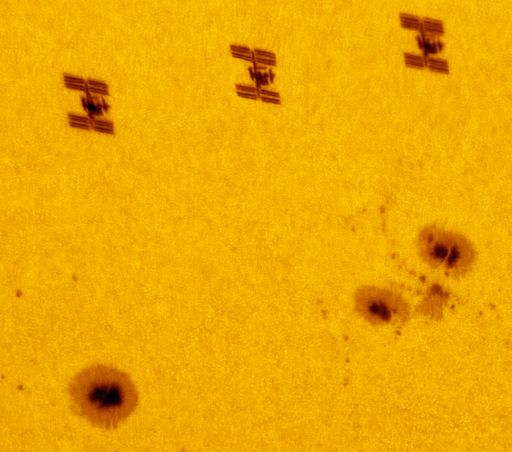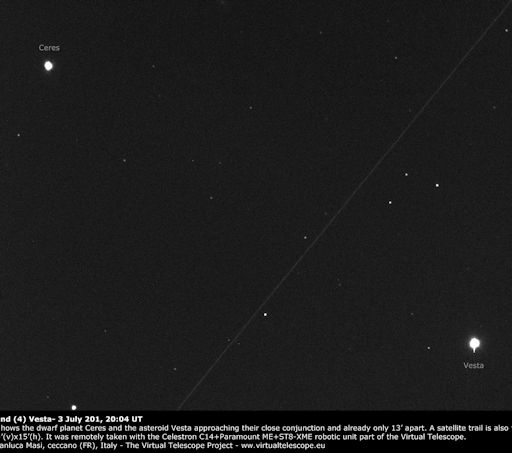Listen to radar echoes from satellites and meteors, live on listener-supported Space Weather Radio. | | | MOSTLY QUIET WITH A CHANCE OF FLARES: Solar activity is low. However, there are four sunspots facing Earth that pose a threat for geoeffective flares: AR2104, AR2107, AR2108, AR2109. NOAA forecasters estimate a 60% chance that one of those active regions will produce an M-flare during the 4th of July weekend. Solar flare alerts: text, voice SPACE STATION TRANSITS THE SUN: As wide as a World Cup football field, the biggest spacecraft ever built makes a impressive silhouette when it passes in front of the sun. Yesterday, Maximilian Teodorescu of Romania caught the winged shadow of the International Space Station in conjuncton with sunspots AR2104 and AR2107: 
"This is my first attempt to catch the station with a small-sensor camera at high magnification," he says. "I managed to catch the ISS in three frames." His wife Eliza was right beside him with her own camera and solar filter, and she caught it too. "The moment was all the more spectacular because the ISS path was almost parallel to the very numerous string of sunspots," she notes. One conjunction after another unfolded as their cameras rolled. With the sunspot number so high, now is a good time to catch ISS-sunspot conjunctions. Check Calsky for local transit predictions. Realtime Space Weather Photo Gallery MONSTER ASTEROIDS CONVERGE: The two most massive objects in the asteroid belt, dwarf planet Ceres and minor planet Vesta, are converging for a close encounter in the night sky on July 4th and 5th. Last night in Italy, Gianluca Masi used a remotely operated telescope to photograph the monster asteroids only 13 arcminutes apart--less than half the width of a full Moon. The line splitting the two is a terrestrial satellite: 
At closest approach on July 5th, the two asteroids will be only 10 arcminutes apart in the constellation Virgo. They are too dim to see with the unaided eye, but easy targets for binoculars and small telescopes. Observing tips are available from Sky and Telescope. Got clouds? You can watch the close encounter online. Choose between Gianluca Masi's Virtual Telescope Project (which begins July 5th at 4:00 p.m. EDT) or Slooh's webcast (July 3rd at 8 p.m. Eastern Daylight Time). Quite near the two asteroids on the sky, though utterly invisible, is NASA's Dawn spacecraft. Dawn recently finished visiting Vesta and is now en route to Ceres. The ion-propelled spacecraft will enter orbit around Ceres next March. Cameras on Dawn will resolve the pinprick of light you see this weekend into a full-fledged world of unknown wonders. Stay tuned for that!
Realtime NLC Photo Gallery
Realtime Comet Photo Gallery
Realtime Aurora Photo Gallery
Every night, a network of NASA all-sky cameras scans the skies above the United States for meteoritic fireballs. Automated software maintained by NASA's Meteoroid Environment Office calculates their orbits, velocity, penetration depth in Earth's atmosphere and many other characteristics. Daily results are presented here on Spaceweather.com. On Jul. 6, 2014, the network reported 9 fireballs.
( 9 sporadics)  In this diagram of the inner solar system, all of the fireball orbits intersect at a single point--Earth. The orbits are color-coded by velocity, from slow (red) to fast (blue). [Larger image] [movies] Potentially Hazardous Asteroids ( PHAs) are space rocks larger than approximately 100m that can come closer to Earth than 0.05 AU. None of the known PHAs is on a collision course with our planet, although astronomers are finding new ones all the time. On July 6, 2014 there were 1489 potentially hazardous asteroids. Notes: LD means "Lunar Distance." 1 LD = 384,401 km, the distance between Earth and the Moon. 1 LD also equals 0.00256 AU. MAG is the visual magnitude of the asteroid on the date of closest approach. | | The official U.S. government space weather bureau | | | The first place to look for information about sundogs, pillars, rainbows and related phenomena. | | | Researchers call it a "Hubble for the sun." SDO is the most advanced solar observatory ever. | | | 3D views of the sun from NASA's Solar and Terrestrial Relations Observatory | | | Realtime and archival images of the Sun from SOHO. | | | from the NOAA Space Environment Center | | | the underlying science of space weather | | 
